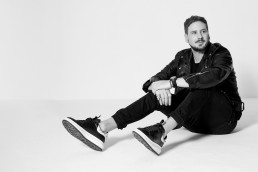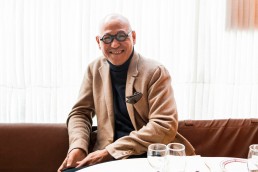Having picked up a number of projects in his first few years of business, South Africa’s rising star continues to flourish, prioritising collaboration and the promotion of his fellow countrymen in every design, writes Guy Dittrich.
Conversations with Tristan du Plessis are always convivial – he’s clearly enjoying himself. And why not? The designer is on a roll having won no less than eight projects in his first year of business – momentum that has continued through Covid times. Undeterred by the travel restrictions in his home country of South Africa, du Plessis’ order book still bulges. Many in southern Africa and the Middle East but also Europe; he will be in Salzburg soon for the first site inspection of a development he has been working on virtually up until now. You can feel the excitement in his anticipation of the trip. “I can’t wait,” he confirms.
Du Plessis’ success is based on early ventures in the nightclub sector. “At the time, being in my early-2os, designing nightclubs was the ultimate dream,” he enthuses. He set up Studio A in 2015, “with the goal of picking up one or two projects in the first year”, but the orders kept coming. You feel he is almost pinching himself in disbelief.
Hell’s Kitchen was Studio A’s first foray – a prohibition-style bar in the Johannesburg suburb of Melville. With a refreshing naivety, du Plessis felt no pressure. “I was getting paid so little that no one expected anything great, so I had fun,” he quips. There he goes again, having fun! But here’s the inside track. “I knew that my friends and I would be drinking there, I wanted to make sure they were impressed,” he continues, “So I did what I thought was cool.”
And cool meant a suitably dark and secretive space with speakeasy doors hidden in bookshelves, meat cleavers on walls and artwork depicting various characters who lived fast and died young. Subdued, dimly lit spaces are a throwback to du Plessis’ earlier nightclub and bar work. “I’m attracted to a dark, moody ambiance that you can feel as soon as you walk through the door,” he notes. “In my world currently it’s a differentiator, coming from a more masculine perspective.”
Coming from an artistic background – his great uncle, Hannes du Plessis, is a well-known artist in South Africa – he found himself drawn to design books featuring the work of Dirand – “I think he’s a genius”– Starck, Dixon et al. Embarking on a marketing degree, little did he know he would be following in their footsteps, having quit the course six months in. He then planned to study architecture and design, but the internship got in the way. Initially a week-long, it got extended and extended. “I didn’t get the chance to study,” recalls du Plessis, “but I did get a lot of hands-on practical experience that I took with me through my career, and still use today.”
Next up was a project where du Plessis had the opportunity “to carve out a niche, a style and aesthetic” that he believed in. Mesh was to be the first luxury business members’ club in Johannesburg and with it came a reasonably high budget. Drawn to the rough luxe aesthetic, du Plessis mixed concrete with luxurious textiles. “An investor in Mesh has one of the largest art collections in the country so I put one of his prized art pieces on a concrete wall,” he explains. “I think that kind of contrast is unexpected and I like it because it’s rebellious.”

The pinks of an African sunset in Jacobus Hendrik Pierneef’s artwork on the wall are delicately picked out in the pair of rose upholstered chairs beneath. The club also has a prime sunset view and the whole becomes “a beautiful moment”, du Plessis notes.
Alongside his current fascination with dark spaces, this idea of juxtaposition is strong for du Plessis, with the designer stating: “I think two extremes together pulls out the best in both.”
At Alice & Fifth, a luxury dining and supper club experience in the windowless basement of Johannesburg’s Sandton Sun Hotel, he contrasts ideas of modernity with nostalgia. “It is a theme that I explore often,” explains du Plessis. “There’s something cool about reinventing elements from the past and making them new again.”
Meanwhile at Chapter Roma, a 47-room boutique in the Italian capital, the client gave du Plessis free rein to be rebellious within the context of the space. In an interesting back story, he recounts how the project came about through a chance exchange on Instagram with the now owner. Here, the play on old and new takes a different tack, with emerald velvet headboards set against exposed brick. “The bricks were 300-years-old, and as a South African, to uncover that heritage was phenomenal. I wanted the history to be exposed.”
Hell’s Kitchen sees a slightly different take on contrast, with rather expensive Moooi Rabbit table lamps having their “shades ripped off” to be repurposed as pendant lamps suspended from the ceiling. Another rebellious move.
Ideas of differentiation come again at Gorgeous George in Cape Town. This is a seminal work for du Plessis, as it is where he “fell in love with hospitality design”. The urban oasis sees the combination of Art Deco and Edwardian buildings, with interiors that place handmade designs and luxurious materials against structural concrete elements and exposed pipework.

“Collaboration plays a central role in how I’d like to be seen as a designer; bringing people into a project and engaging a team, not making it solely about me.”
Art is also part of the package, with du Plessis commenting that “the power of collaboration through artists is very important in all my projects”. Take, for example, the work of just two of those South African creatives, the playfully whimsical crocodile swing chair by Porky Hefer and the guestrooms murals by David Brits. “Collaboration plays a central role in how I’d like to be seen as a designer; bringing people into a project and engaging a team, not making it solely about me,” he continues, the greater idea being the promotion of a South African spirit, likening Gorgeous George to a platform showcasing local design talent at an international level. “Nearly everything is bespoke, handmade and handpainted, from the tabletops to the walls to the ceramic coffee tables outside,” he enthuses of contributors that include Gregor Jenkin, Southern Guild Gallery, Lucie de Moyencourt and Jana + Koos.
And it was Jana + Koos that helped Gorgeous George scoop the Visual Identity category at AHEAD MEA in 2019. The hotel collected three other trophies – for Renovation, Restoration & Conversion, Suite and the overall win as the region’s Hotel of the Year. Not a bad haul, particularly when a shortlisting in the Bar, Club and Lounge category for Alice & Fifth is included. Du Plessis was subsequently invited to join the judging panel in 2021. “Being a judge for AHEAD has been an amazing experience,” he explains. “I was happy to exchange and hear the differing viewpoints of my peer group and better appreciate the great openings in the region. It really hit home to me how important hospitality experience and design is.”
Of the order book, du Plessis lists current projects in Dubai: the African-inspired San Beach Club at Palm Jumeirah, which recently broke ground; the Peruvian-Japanese, Nikkei-style eatery Clay; and Loren, an Italian-inspired restaurant. Du Plessis also shares a pair of “lockdown babies” in Johannesburg – the already trading Tang, a Pan-Asian dining destination with a hint of nightclub – and Kōl – an izakaya-inspired restaurant that he “threw himself into head-first during lockdown as source of much-needed escape”.
His first large-scale luxury hotel project will open in Abu Dhabi in 2023 and is a full scope remit for one of Accor’s lifestyle brands. He also has another for a yet-to-be-disclosed Accor luxury brand, this time in Jeddah, where he will cover F&B components and a series of penthouses.
Despite his early success, in fact possibly because of it, du Plessis has a disarming charm and humility about him. “I started off with nothing, no investment. I called up one of my friends and set up my office from his boardroom,” he relates about the establishment of Studio A, the business name used for his South African portfolio. “I never thought I would be doing any international work, which is why I had to change the name to Tristan du Plessis Studio. There are dozens of Studio As all over the world!”
Du Plessis has a loyal social media following too, he was named GQ’s Designer of the Year in 2019 and was recently accepted to endorse Courvoisier brandy. This could go to your head, in more ways than one! However, a grounded naivety and the importance he attaches to collaboration and the promotion of his fellow countrymen make him human. The power of his design makes him one to watch. And you can bet he’ll still be having fun.

CREDITS
Words: Guy Dittrich
Related Posts
5 October 2021
Meeting… Ole Scheeren
4 October 2021
Meeting… Tony Chi
20 May 2021




